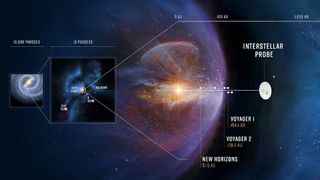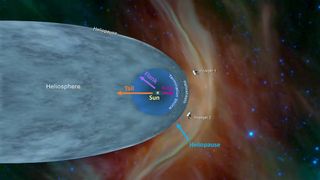This article was originally published on The conversation. The publication contributed to the Space.com article Expert Voices: Editorials and Reflections.
Sarah Spitzer is a researcher in climate and space science and engineering at the University of Michigan.
The sun warms the Earth, making it habitable for humans and animals. But that’s not all, and it affects a much larger area of space. The heliospherethe area of space influenced by the sun, is more than a hundred times larger that the distance between the sun and the Earth.
The Sun is a star that constantly emits a steady stream of plasma (highly energetic ionized gas) called the solar wind. In addition to this steady solar wind, the Sun also occasionally emits plasma eruptions called coronal mass ejections, which can contribute to the northern lights, as well as explosions of light and energy called flares.
Plasma from the Sun expands into space, along with the Sun’s magnetic field. Together, they form the heliosphere within the surrounding local interstellar medium: the plasma, neutral particles, and dust that fill the space between stars and their respective astrospheres. Heliophysicists like me want to understand the heliosphere and how it interacts with the interstellar medium.
The eight planets known in the solar systemTHE Asteroid belt between March And Jupiterand the Kuiper Belt – the band of celestial objects beyond Neptune that includes the planetoid Pluto – all are in the heliosphere. The heliosphere is so large that Kuiper Belt objects orbit closer to the Sun than to the closest limit of the heliosphere.
Related: Something scary is happening at the edge of the solar system

Protection of the heliosphere
When distant stars explode, they expel large amounts of radiation into interstellar space as highly energized particles known as cosmic raysThese cosmic rays can be dangerous to living organisms and can damage electronic devices and spacecraft.
The Earth’s atmosphere protects life on the planet the effects of cosmic radiation, but even before that the heliosphere itself acts as a cosmic shield against most interstellar radiation.
In addition to cosmic radiation, neutral particles and dust regularly flow into the heliosphere from the local interstellar medium. These particles can affect the space around the Earth and can even modify How the solar wind reaches Earth.
Supernovae and the interstellar medium may also have influenced the origins of life And the evolution of humans on Earth. Some researchers predict that millions of years ago, the heliosphere came into contact with a cloud of cold, dense particles in the interstellar medium that caused the heliosphere to shrinkexposing the Earth to the local interstellar medium.
An unknown form
But scientists don’t really know what shape the heliosphere is. Models vary in shape from spherical to cometary to crescent shape. These predictions vary in size from hundreds to thousands of times the distance of the sun To the earth.
Scientists, however, have defined the direction in which the Sun moves as the “nose” direction and the opposite direction as the “tail” direction. The nose direction should have the shortest distance to the heliopause, the boundary between the heliosphere and the local interstellar medium.

No probe has ever been able to observe the heliosphere from the outside or properly sample the local interstellar medium. This could allow scientists to learn more about the shape of the heliosphere and how it interacts with the local interstellar medium, the space environment beyond the heliosphere.
Voyager Crossing the Heliopause
In 1977, NASA launched the Mission Voyager:His two spaceships flew past Jupiter, Saturn, Uranus And Neptune in the outer solar system. Scientists have determined that after observing these gas giantsThe probes crossed the heliopause separately and entered interstellar space in 2012 and 2018, respectively.
While Travel 1 and 2 are the only probes to have potentially ever crossed the heliopause, they are well beyond their intended mission lifetime. They can no longer returns the necessary data as their instruments slowly fail or die.
These spacecraft were designed to study planets, not the interstellar medium, so they do not have the proper instruments to take all the measurements of the interstellar medium or the heliosphere that scientists need.
This is where a possible interstellar probe mission could come into play. A probe designed to fly beyond the heliopause would help scientists understand the heliosphere by observing it from the outside.
An interstellar probe
Since the heliosphere is so large, It would take decades for a probe to reach the boundaryeven using gravity assist of a massive planet like Jupiter.
The Voyager spacecraft will no longer be able to provide data from interstellar space until an interstellar probe leaves the heliosphere. And once the probe is launched, depending on the trajectory, it will take about 50 years or more to reach the interstellar medium. This means that the longer the probe is, the longer it will not be able to reach the interstellar medium. NASA The longer we wait to launch a probe, the more likely scientists will be left without missions operating in the outer heliosphere or the local interstellar medium.
NASA plans to develop a interstellar probeThe probe was to take measurements of plasma and magnetic fields in the interstellar medium and take images of the heliosphere from outside. To prepare, NASA asked more than 1,000 scientists for input on the mission concept.
The initial report It was recommended that the probe follow a trajectory about 45 degrees from the direction of the nose of the heliosphere. This trajectory would retrace part of Voyager’s path, while reaching new regions of space. In this way, scientists could study new regions and revisit some partially known regions of space.
This path would give the probe only a partially tilted view of the heliosphere, and it would not be able to see the heliotai, the region scientists know the least about.
In the heliotail, scientists predict that the plasma that makes up the heliosphere mixes with the plasma that makes up the interstellar medium. This happens through a process called magnetic reconnectionwhich allows charged particles to flow from the local interstellar medium into the heliosphere. Just like neutral particles that enter through the nose, these particles affect the space environment within the heliosphere.
In this case, the particles are charged and can interact with the solar and planetary magnetic fields. These interactions occur at the boundaries of the heliosphere, very far from the Earth, but they affect the composition of the interior of the heliosphere.
In a new study In a study published in Frontiers in Astronomy and Space Sciences, my colleagues and I evaluated six potential launch directions from nose to tail. We found that instead of exiting near the nose direction, a trajectory crossing the side of the heliosphere toward the tail direction would give the best perspective on the heliosphere’s shape.
A trajectory in this direction would offer scientists a unique opportunity to study an entirely new region of space within the heliosphere. As the probe exits the heliosphere and enters interstellar space, it would be able to view the heliosphere from the outside at an angle that would give scientists a more detailed idea of its shape, particularly in the controversial tail region.
Ultimately, no matter which direction an interstellar probe is launched, the scientific results it will bring back will be invaluable and literally astronomical.